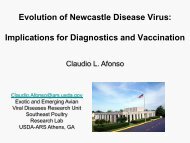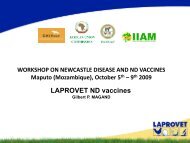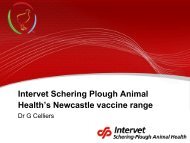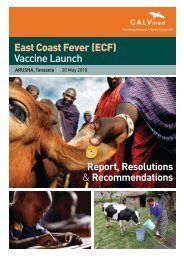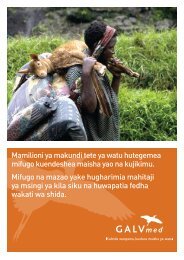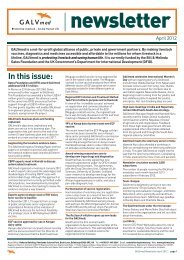A Path to Prosperity New Directions for African Livestock
GALVmed Impetus Strategy Paper
GALVmed Impetus Strategy Paper
- No tags were found...
Create successful ePaper yourself
Turn your PDF publications into a flip-book with our unique Google optimized e-Paper software.
5.3 <strong>New</strong> Nutrition Technologies<br />
<strong>for</strong> Africa<br />
There are a range of simple and highly technical<br />
feed technologies that might benefit from both an<br />
AIS and GALVmed portfolio review approach.<br />
An example of a simple technology with a potentially<br />
very high impact is the utilisation of oilseed<br />
meals/cakes in <strong>African</strong> ruminant production. It is a<br />
technology that has been adopted in South Asia but<br />
has not been adopted at scale in SSA. Most cereal<br />
crop residues are deficient in the protein, sulphur<br />
and other minerals vital <strong>for</strong> proper functioning of the<br />
rumen. Oil seed cakes supplement the deficiencies<br />
<strong>to</strong> improve rumen function and significantly increase<br />
productivity. For example, supplementation of a low<br />
quality pasture hay with cot<strong>to</strong>nseed meal (CSM) can<br />
produce a four fold increase in liveweight gain when<br />
fed at 0.5% of body weight. Leng 99 showed that daily<br />
oilseed cake supplementation at 0.35% of body<br />
weight <strong>to</strong> steers produced a response of 1.2 kg<br />
live weight gain per kg of the supplement.<br />
This efficiency of conversion of oilseed cake <strong>to</strong> body<br />
weight is better than that of grains obtained in pigs.<br />
Whilst such a level of production will be affected<br />
by breed, animal health and other lives<strong>to</strong>ck<br />
management practices, the conversion of oilseed<br />
cakes <strong>to</strong> useful products should not be undervalued<br />
when compared <strong>to</strong> feeding human-edible grains <strong>to</strong><br />
pigs or poultry. Such growth rates could make small<br />
holder production much more competitive.<br />
Furthermore, the technology could be utilised by<br />
both large and small ruminants.<br />
FAO AGA has calculated that in 2007, 264,515<br />
<strong>to</strong>nnes of oilseed cake were exported from<br />
sub-Saharan Africa and if this was strategically<br />
used within the continent, an additional 132,258<br />
<strong>to</strong>nnes of meat could be produced. This could<br />
reduce Africa's annual meat imports by 12.6%.<br />
Furthermore, importing oilseed cakes would be an<br />
attractive option. As one <strong>to</strong>nne of oilseed imported<br />
has a value of US$208 in sub-Saharan Africa and<br />
one <strong>to</strong>nne of oilseed cake, when strategically fed,<br />
produces 0.50 <strong>to</strong>nne of meat (with a value of<br />
US$1691 when exported and $610 when imported<br />
in<strong>to</strong> sub-Saharan Africa) a substantial value<br />
addition could be achieved by using oilseed cakes<br />
<strong>for</strong> meat production.<br />
There would be further significant spin offs <strong>to</strong> oil<br />
seed cake supplementation. Supplementation has<br />
shown <strong>to</strong> reduce the age of first calving from 4 –5<br />
years <strong>to</strong> 1.5 – 2 years and inter-calving interval<br />
from over 2.5 years <strong>to</strong> 1 – 1.5 years. Enhancing<br />
reproductive efficiency alone results in an<br />
approximately two-fold increase in the number of<br />
calves <strong>for</strong> fattening. Higher immunity due <strong>to</strong> good<br />
nutrition could decrease the occurrence of diseases.<br />
In addition, good nutrition of the dam would<br />
decrease the number of calves that die at birth or<br />
soon after birth. This higher productivity would<br />
decrease emissions of methane per unit of animal<br />
product <strong>for</strong>mation. Finally, use of crop residues<br />
could decrease pressure on pasture lands.<br />
Of course, introduction of this technology isn’t<br />
simple. It relies on the value chain being developed<br />
and areas with easy access <strong>to</strong> oil seed cakes taking<br />
the lead. FAO there<strong>for</strong>e plans <strong>to</strong> sustainably<br />
intensify lives<strong>to</strong>ck production using strategic<br />
supplementation of crop residues and oilseed<br />
cakes. If an innovations systems approach is taken,<br />
this will require a range of ac<strong>to</strong>rs with concerted<br />
ef<strong>for</strong>ts <strong>to</strong> bring their experience and knowledge <strong>to</strong><br />
designing more effective support and investments<br />
in this type of feed supplementation.<br />
The Impetus Strategy Paper I Page 39



